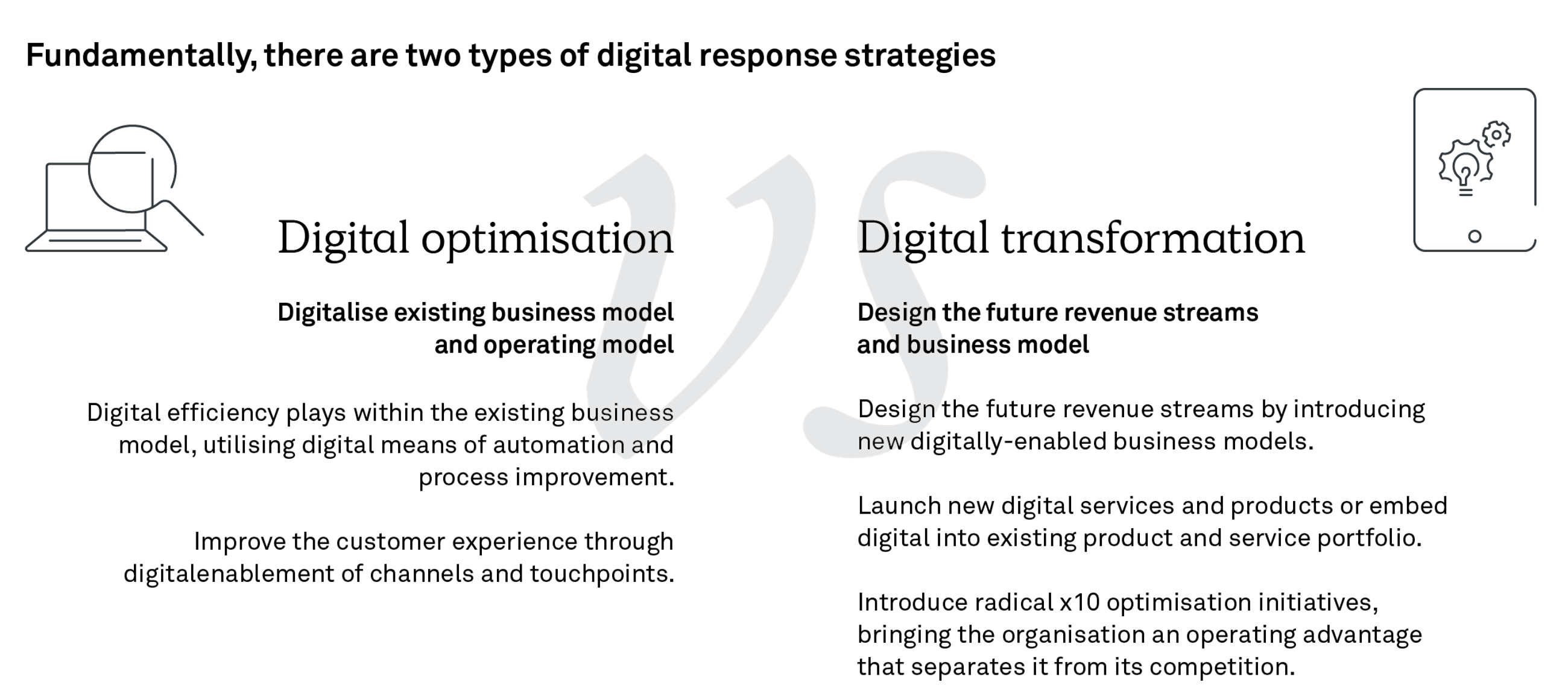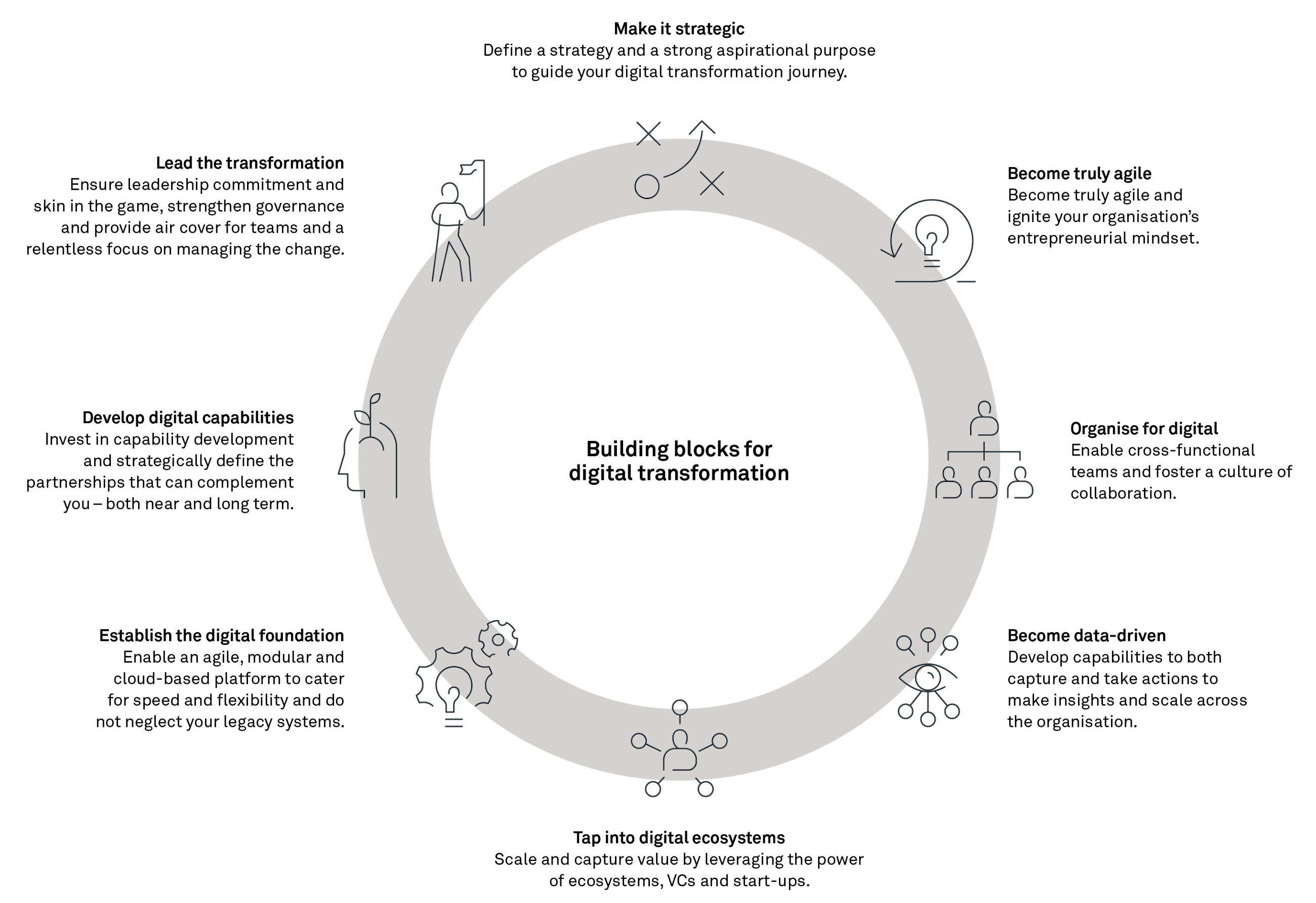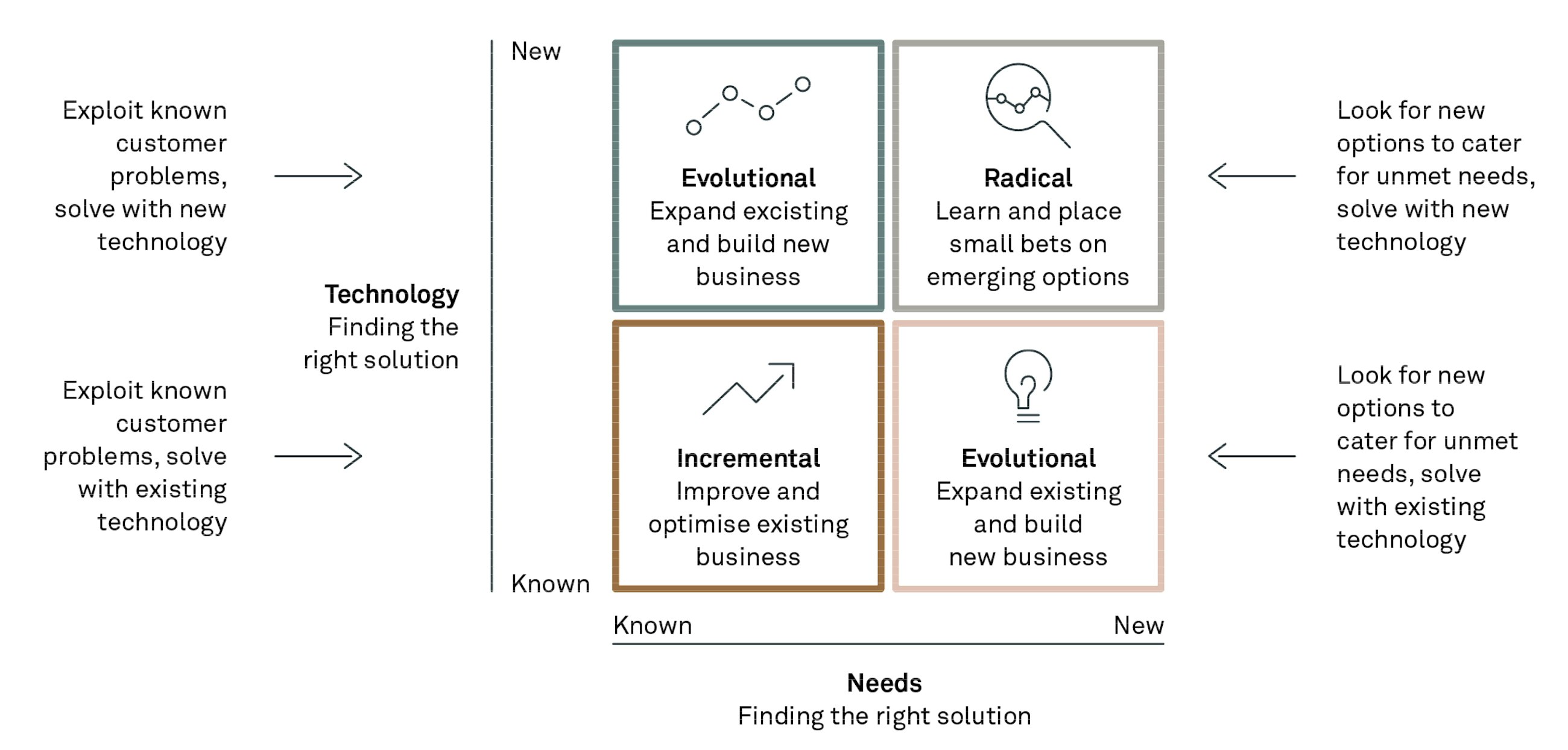13 December 2023
Originally published 30 April 2019 - updated December 2023
Today, all organisations must be digital and play to win in a digital arena. But what should you focus on to create and capture value from digital transformation (DX)? These are the things we have observed successful organisations do to ignite their digital journey.
Digital transformation is consistently a top strategic priority of most corporations today and is identified as the primary source of new growth opportunities and a key enabler of efficiency plays leading to profitability and competitive advantages. Business leaders are increasingly experiencing how emerging technologies have enabled new business models and removed industry barriers, allowing new types of competitors to enter and leading to changed dynamics of their industry. All industries are undergoing substantial technology-driven change, and this provides opportunities for growth and profitability for organisations adapting ahead of the competition and setting the standards. At the same time, it is a complex challenge for many organisations struggling to change and capture value from digitalisation with a staggering estimate of 70% of all digital transformation efforts failing to fully deliver the intended value.
A one-size-fits-all digital playbook does not exist, and many leaders are left with identifying what this actually means for the organisation looking to separate the hype on digital disruption from reality and defining when, where and how much to react to disruptive threats – knowing that if you act ineffectively, you risk wasting your resources and being disrupted anyway. The incumbents have in many industries managed to strike back on the emerging digital start-ups leveraging their strategic position and capabilities to ensure a sustainable position in their ecosystem – for now – yet the competition is increasingly fierce with all players looking to capture more digital value and set new standards.
How do you tap into the endless opportunities of digitalisation and capitalise positively on the technology-driven transformation that is currently changing your industry?
dig-i-tal trans-for-ma-tion/dijidltran(t)sfər’māSH(ə)n/ noundig-i-tal trans-for-ma-tion/dijidltran(t)sfər’māSH(ə)n/ noun (DX)
DX = digital strategy + organisational change
In business, a fundamental change, a metamorphosis, in how companies generate value for their owners and other stakeholders is achieved by applying digital technologies and ways of working to all aspects of the business.
Fundamentally, there are two types of digital response strategies. 1: Digital optimisation, where the organisation is applying technology to grow the current business model. 2: Digital transformation, where the organisation is looking to design new digitally enabled revenue streams and business models or apply new technology leading to radical optimisation initiatives changing the overall competitive position of the organisation (Figure 1).
Here is our viewpoint on what to focus on to create and capture value from digital transformation based on what we have observed successful organisations do to successfully ignite their digital journey.
Building blocks for digital transformation
1 Make it strategic
To engage and align the organisation on a shared digital aspiration, it is imperative to formalise a vision and a strategy providing the direction for its achievement.
The strategy should formalise the level of innovation the organisation seeks to explore as well as the focus areas for digital transformation whether they are digital innovation of new products and services, digitalising the customer experience, digitalising operations or a mix of all (Figure 2). Organisations that have digitalisation as a core element of their value proposition are often able to incorporate their digital strategy into their corporate strategy, while other organisations succeed by establishing a dedicated digital strategy to drive their efforts. What is important is that the vision is clear, and that strategy is understood and alive in the organisation. Rather than focusing too broadly, the chance of success is higher when starting in a selected function or BU and scaling from there. Make it big enough to matter but small enough to succeed.
The strategy must be evolving and constantly aligned to the rapidly changing environment to create optimal value, scouting and assessing new technologies to assess potential and applicability and enable early capability development to be able to leverage emerging technologies once they mature. Simply rethinking strategy for the digital age is not enough – you need to rebuild your organisation for a world of constant digital change, which the strategy must reflect. It is the only way to sustain and grow your business.
2 Become truly agile
Digital transformation is all about continuously working in iterations to explore technologies and develop functionalities that can be tested, improved and released in a rapid fashion. Furthermore, it is about embracing an agile mindset of empowering teams to set priorities and design solutions as they learn while applying transparency and accountability with a focus on value creation. Applying a design thinking approach and nurturing a culture of exploration where failing early is a strength rather than an indication of poor judgment. Build capabilities that enable the organisation to develop prototypes and engage with customers to capture their valuable feedback to guide solution design prior to implementing and scaling new solutions. Digitally advanced organisations incorporate this as a standard process in their development of new business models and digital products and reap the benefits of bringing solutions faster to market in addition to becoming customer-centric and really listening to the voice of customers to fully understand their ideas, pains and needs and by de-risking new technology investments.
In essence, digital transformation is an ongoing exploratory journey of innovation for which you cannot plan ahead. Change is a constant, and being able to swiftly apply new priorities and reallocate resources without having to await yearly budget allocation processes is thus key.
3 Organise for digital
Many organisations have experimented with various digital organisational structures and placed accountability for leading the digital transformation with business and IT or introduced new digital roles in the organisation, such as CDOs. There is no golden strategy to approach this as we have seen organisations succeed and fail when placing responsibility for digital transformation with business and IT and when creating a dedicated digital business unit.
What is imperative is that silos are overcome, and the entire organisation becomes ready for transformation – not just individual business units. Regardless of ownership, we see successful internal digital delivery models in a business development setup and outside the organisation as “project X” – both depending on the digital strategy and the ambition level for innovation (Figure 2). What constitutes successful organisations is that they realise that digital transformation is neither a pure technology transformation nor a pure business-driven transformation. They succeed in establishing an organisational structure that caters to cross-functional collaboration and teams with diverse capabilities spanning commercial aspects, design and technology.
4 Become data-driven
Becoming data-driven is critical to digital transformation as you need to shape the future based on rapidly changing market conditions. The organisation must be smarter and faster than the competition. To do this, leveraging data and analytics is a core capability. But it is not just a job for the BI & Analytics team – the whole organisation must be data-driven, as deriving action from insights is an organisational capability, not a technological one. Only when data has become democratised, the full organisation can leverage and transform.
In essence, the organisation needs to master three key skills:
- Skills and organisational changes required to analyse, derive insights and encourage data-driven decision-making.
- Ability to source and aggregate new data sources, integrate new analytics capabilities and partner with third-party analytical services.
- Using data for strategic and competitive advantage by enhancing existing product offerings or developing new ones and radically improving operations.
Data is the fuel of digital transformation, but it is not the quantity of data that differentiates leading digital organisations from the rest; it is their ability to extract insights and leverage these to gain a competitive edge. This entails developing a data strategy and investing in foundational capabilities such as master data management in parallel with developing data science and analytic capabilities.
5 Tap into digital ecosystems
Digital ecosystems are emerging across industries and changing industry boundaries and how organisations create value for customers. Leveraging gateways, such as APIs, many organisations are tapping into ecosystems in, and outside, their industry and are sharing and consuming data to provide value to customers.
Engaging in a digital ecosystem enables improved realisation of the organisation’s technology stack, and cohabitating cloud-based platforms with third parties in a software-as-a-service model can enable easy access to functionalities and data that can be leveraged and packaged to provide value to customers in their specific context.
Companies that succeed in building a digital ecosystem enjoy exponential growth and profits – 27-32% higher than industry averages (Gartner 2022).
6 Establish the digital foundation
Establishing a solid digital foundation and platform has proven to be one of the greatest obstacles to digitalisation. The reality for most organisations is that numerous monolithic back-end legacy systems are critical sources of data and critical business process enablers, but they are so complex that managing any type of change to these systems is governed by cumbersome governance and release management processes. This is at a high risk of becoming the bottleneck that kills rhythm and energy in the digital innovation process and potentially hinders the organisation in responding to changing customer needs and market conditions. To cater to this, organisations need to ensure a balanced approach where a runway for new digital solutions is introduced whilst legacy is modernised, and technical debt is gradually reduced. Some organisations start this journey greenfield while others engage in a bimodal two-speed IT setup enabling access to critical data while providing a digital governance mechanism catering to rapid releases.
A well-defined enterprise architecture strategy is essential to set the direction for the digital landscape and to move towards a modular core that provides security and infrastructure flexibility, enables reuse of data services and APIs and can cater for applying modular strategies across the application layer whether it is bespoke, best of suite or best of breed.
7 Develop digital capabilities
The speed at which new technologies emerge and the increased complexity in selecting, developing and implementing the right digital solutions entail a broad selection of digital capabilities. The war for digital talent is on as few organisations can recruit and scale at the needed pace. No organisation has ever outsourced its way to digital excellence; however, by engaging in partnerships, new strategic capabilities can be enabled faster and, over time, be insourced into the organisation with the aim of having approximately 70-80% of tech talent in-house. Most organisations start out utilising a high number of externals and gradually insource capabilities as they progress and mature on their DX journey.
As organisations tap into different ecosystems, they must also increasingly be able to engage with different partners that complement their capabilities to ignite their digital transformation.
While it is imperative to identify new partners that can complement and bring sought-after capabilities to the table, organisations need to digitally upskill the existing organisation in parallel, hereby leveraging the knowledge and insights of current operations and technologies and gradually applying and building new skills via carefully designed learning journeys enabling the workforce to adapt digitally enabled use cases and proactively identify new areas and use cases for improvement.
8 Lead the transformation
Leadership commitment at the top level is essential to success and requires leaders to have skin in the game by having a relentless focus on managing the change and committing to changes and targets, allocating their most talented resources. Leadership needs to provide an air cover for teams to be explorative and consistently test new digital opportunities aiming to de-risk investments by failing early. This is a major change in most organisations and requires a swift mindset and culture which can only take place with the right leadership commitment and involvement.
Approach
Spend as much time reinventing as optimising the existing business model and seek to target a minimum of 15% EBITDA to make the transformational impact substantial and strategic. Applying an approach by focusing on one business unit or function at a time and scaling across when the case is proven rather than starting the journey with an all-or-nothing or end-to-end focus.
To ensure that the transformation becomes sustainable rather than a single digital programme, a balanced approach needs applied by a portfolio of digital investments spanning growth and efficiency plays with a mix of quick wins and large strategic initiatives in parallel to new capability development identified as strategic and potentially differentiating in the long term yet still at a fully explorative and hypothesis-based stage and not evaluated via a single business case. Every business must place bets on innovation ventures outside its core if it hopes to achieve sustainable long-term growth. As its existing business model matures and loses the potential for growth, innovation of this kind is critical.
Setting up a structure to track and measure progress by applying a set of digital measures to steer and guide the direction of the digital transformation:
- Value creation, e.g. ROI on digital investments, % of business that is digitally based, level of investments that are sustainable (reinvested).
- Tracking employees becoming increasingly digital, e.g. digital talent recruited, investments in digital workforce development.
- Faster or data-driven decisions, e.g. data utilisation in decisions, decision-making time.
- Digital delivery, e.g. time to market of digital solutions.
Emerging technologies will continue to drive complexity and increased uncertainty, and we are sure to see radical change happen faster and impact more industries than ever before as we are currently witnessing with the generative AI wave. Organisations that dare to be bold and proactively seek to reinvent their business model and digitalise their operations rather than solely repeating the steps of competitors will succeed in the long run. Every organisation is now a digital organisation and must play to win in the digital arena.







